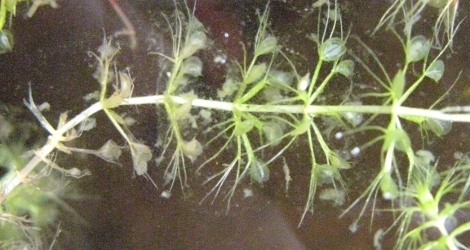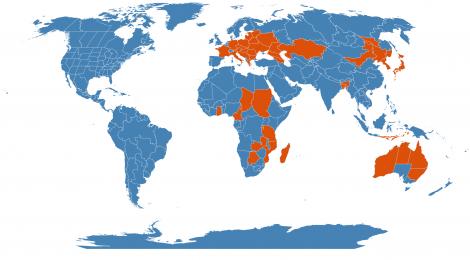Accession Data:
Aldrovanda vesiculosa L.
- Common Name: Waterwheel Plant
- Family: Droseraceae Salisb.
- Description: This species is a perennial, free-floating, rootless aquatic herbaceous plant, with a simple or sparsely branched stem possessing successive whorls of bristled, prey-catching leaves. The leaves are arranged in whorls of 4-9, measuring up to 23 mm in diameter, and are basally fused with a swollen, dorsally flattened petiole that broadens upwards before dividing into 3-8 terminal, filiform bristles of 4-8 mm length. Stem length is dependent upon water quality, prey abundance and irradiance, but is commonly between 6-20 cm. The compact, whorled structure of the species provides the plant with an almost cylindrical appearance, and gives rise to the species common name of the "Waterwheel Plant".4
- Culture: Use a large tank in a sunny location, with a layer of peat, sphagnum, and loam on the bottom. Small aquatic animals (snails, daphnia, etc.) control algae and provide prey, and may be introduced along with muck and debris from a pond bottom, or from an established tank. A pot of Typha or some large, easily thinned floating aquatics like Eichhornia, are useful companion plants. Tanks should be carefully flushed with clear or DI water periodically, to prevent the buildup of salts.
Growth should be rapid in warm weather; Darwin Australia is tropical, and Aldrovanda from that locality is definitely at its best in the summer months. The addition of trace elements (esmigram) may be beneficial if growth slows despite appropriate temperatures and lighting. CO2 injection is also appreciated. Keep floating plants thinned.
- USDA Zone: GEN_COLL
Accession Data:
- Accession # 200400164
- Source: Matt Opel
- Provenance: Darwin, Australia
- Accession Date: 09-08-2004
- Bench: 2310 - Temperate Carnivores
- Currently: active - healthy
- Qty: 1 confirmed on 04-10-2025
- Restrictions:
- IUCN Red List: Endangered Species
- IUCN Red List: Endangered Species
Classification:
- Division: Magnoliophyta
- Class: Magnoliopsida
- SubClass: core eudicots
- Order: Caryophyllales
- SubOrder:
- Family: Droseraceae
- SubFamily:
- Tribe:
- SubTribe:
Flowering Data:
This accession has been observed in bloom on:| Year | Jan | Feb | Mar | Apr | May | Jun | Jul | Aug | Sep | Oct | Nov | Dec | ||||||||||||||||||||||||||||||||||||||||
|---|---|---|---|---|---|---|---|---|---|---|---|---|---|---|---|---|---|---|---|---|---|---|---|---|---|---|---|---|---|---|---|---|---|---|---|---|---|---|---|---|---|---|---|---|---|---|---|---|---|---|---|---|
| 2025 | ||||||||||||||||||||||||||||||||||||||||||||||||||||
| 2024 | ||||||||||||||||||||||||||||||||||||||||||||||||||||
| 2023 | ||||||||||||||||||||||||||||||||||||||||||||||||||||
| 2022 | ||||||||||||||||||||||||||||||||||||||||||||||||||||
| 2021 | ||||||||||||||||||||||||||||||||||||||||||||||||||||
| 2020 | ||||||||||||||||||||||||||||||||||||||||||||||||||||
| 2019 | ||||||||||||||||||||||||||||||||||||||||||||||||||||
| 2018 | ||||||||||||||||||||||||||||||||||||||||||||||||||||
| 2017 | ||||||||||||||||||||||||||||||||||||||||||||||||||||
| 2016 | ||||||||||||||||||||||||||||||||||||||||||||||||||||
| 2015 | ||||||||||||||||||||||||||||||||||||||||||||||||||||
| 2014 | ||||||||||||||||||||||||||||||||||||||||||||||||||||
| 2013 | ||||||||||||||||||||||||||||||||||||||||||||||||||||
| 2012 | ||||||||||||||||||||||||||||||||||||||||||||||||||||
| 2011 | ||||||||||||||||||||||||||||||||||||||||||||||||||||
| 2010 | ||||||||||||||||||||||||||||||||||||||||||||||||||||
| 2009 | ||||||||||||||||||||||||||||||||||||||||||||||||||||
| 2008 | ||||||||||||||||||||||||||||||||||||||||||||||||||||
| 2007 | ||||||||||||||||||||||||||||||||||||||||||||||||||||
| 2006 | ||||||||||||||||||||||||||||||||||||||||||||||||||||
| 2005 | ||||||||||||||||||||||||||||||||||||||||||||||||||||
References (internal):
- Aquatic Plants
- Mesopleustophyte
- IUCN Redlist Endangered Species
- Carnivorous Plants
- EEB 3203 - Developmental Plant Morphology
- Plants used in EEB 2244 - General Ecology
- Thigmonasty
- Accessions with Embedded Video Files
- EEB Greenhouse Holdings native to: Austria / Czechoslovakia / Germany / Hungary / Poland / France / Bulgaria / Greece / Italy / Romania / Yugoslavia / Belarus / Baltic States / Central European Russia / South European Russia / Northwest European Russia / Ukraine / Ghana / Burundi / Cameroon / Rwanda / Chad / Sudan / Tanzania / Mozambique / Zambia / Botswana / Madagascar / Amur / Primorye / Kazakhstan / North Caucasus / Transcaucasus / Inner Mongolia / Manchuria / Japan / Korea / Assam / Bangladesh / Lesser Sunda Is. / New South Wales / Northern Territory / Queensland / Western Australia
References (external):
- Aldrovanda Project
- The Plant List (2013). Version 1.1. Accessed 26 February 2015.
- WCSP (2015). World Checklist of Selected Plant Families. Facilitated by the Royal Botanic Gardens, Kew. Accessed 26 February 2015.
- Aldrovanda vesiculosa at IUCN Redlist. Last accessed on Tuesday, May 30, 2017.
- Poppinga, S., Smaij, J., Westermeier, A.S. et al. Prey capture analyses in the carnivorous aquatic waterwheel plant (Aldrovanda vesiculosa L., Droseraceae). , Sci Rep 9, 18590 (2019) doi:10.1038/s41598-019-54857-w. Last accessed on Friday, 13 December, 2019.
data regenerated on Thu, 10 Apr 2025 13:12:01 -0400 [bcm v4.0]
Images:

Additional images for this accession:
Click on thumbnails to enlargeCurrent Accessions in the Droseraceae
- Aldrovanda vesiculosa W/C


- Dionaea muscipula


- Drosera aliciae W/C


- Drosera auriculata


- Drosera binata


- Drosera binata W/C


- Drosera binata var. multifida extrema

- Drosera callistos

- Drosera capensis W/C


- Drosera capillaris W/C

- Drosera cuneifolia


- Drosera dielsiana


- Drosera filiformis var. filiformis W/C

- Drosera filiformis var. tracyi

- Drosera hartmeyerorum


- Drosera macrantha

- Drosera pygmaea W/C


- Drosera ramellosa


- Drosera regia W/C


- Drosera spatulata ssp. lovellae W/C

- Drosera venusta
- Drosera x legrandii

 = indicates flowering in past 14 days
= indicates flowering in past 14 days
 = images available for this accession
= images available for this accession
 = map available for this accession
= map available for this accession
 = accession added within past 90 days
= accession added within past 90 days


